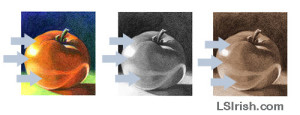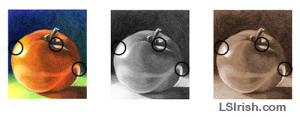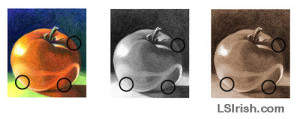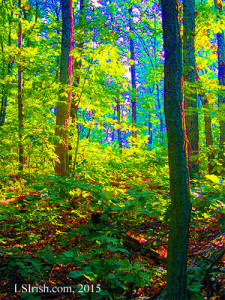Over the last two days we have been exploring how light, shadows, color, and tonal value are created in a photograph and how they affect the sepia pyrography wood burning. Today we will look at repeated tonal values, black and white contrast, and adjacent mid-tone in our gray-scale photos. Next we will take a look at how your eye and brain sees and interrupts images.
Shadow and Light in Pyrography Photos – Day 1
Shadow and Light in Pyrography Photos – Day 2
Shadow and Light in Pyrography Photos – Day 3
Shadow and Light in Pyrography Photos – Day 4
A shade of tonal value will be repeated several times throughout any image or photograph. In the tomato drawing three areas that been marked that all share the same tonal value. Each of these areas would receive the same pyrography burning to keep the tones equal.
You will find similar or equal tonal values throughout your gray or sepia toned image even though those same areas show different hues in the color photo. A medium green, medium red, and medium blue may share the same medium sepia tonal value.
Placing one or two areas of the extreme tonal values next to each other gives the eye a place to compare the darkest and palest tones. The brightest highlight on this tomato lies in the upper left and is adjacent to the blackest tone of the drawing, found in the background area. These two tonal value areas set the whitest and darkest tones of your tonal value scale.
Working an area of high contrast – white against black – creates a visual boundary for your tonal value scale. All mid-tones must fall between these two extremes. The boundary tones do not need to be pure white or pure black; a gray-scale can be created starting with a pale gray and ending with a dark gray.
In any gray scaled photo you will discover adjacent areas in two different elements that have the same tonal value. In these areas the defining line between the two elements seems to disappear. In our sample there are three areas where the body of the tomato and either the table surface or background share the same tonal value.
When two areas share one tonal value you can adjust one or both of the mid-tone values in a burning to create some contrast. Even a very small change in one area, either going a bit lighter or darker, is enough to redefine your boundary lines.
How the Brain Interrupts an Image
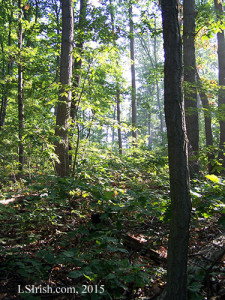 Notice that I did not say how the eye sees an image. The eye receives information about an image or photo in two distinct manners, it is only when those two pieces of information are combined by the brain do we see an image. So where the eye gathers information it is the brain that interrupts that information into one image.
Notice that I did not say how the eye sees an image. The eye receives information about an image or photo in two distinct manners, it is only when those two pieces of information are combined by the brain do we see an image. So where the eye gathers information it is the brain that interrupts that information into one image.
Inside of the eye are two receptors – the cones and rods. The cones of the eye gather information about color, it determines if an objects is red, yellow, or blue. The rods, the second eye receptor, evaluates the amount of light each area is receiving; the rods create the gray-scale tonal values that we use in pyrography. Our sample photo for this section is a wooden hill just after sunrise.
The sample photo has been altered to remove as much shading as possible while emphasizing the color hue of each area. The gray-green leaves of the forest are now broken into areas of yellow, yellow-green, deep green, and blue. The tree trunks show greens, reds, and yellows.
You can see the colors contained in light when you view a rainbow created through a prism, called a spectrum. Each color in the spectrum has its own specific wave length. When light strikes an object most of those color waves are absorbed by the object. Those that are not absorbed bounce off the object to be received by our eye.
So the color of any object and therefore the color that our eye cones receive are the light wave lengths that the object rejects. We don’t see green leaves, we see the green light waves that have bounced off of the leaves.
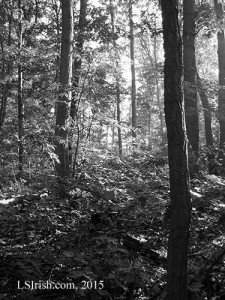 Sepia or Gray Scale Receptors – Rods
Sepia or Gray Scale Receptors – Rods
What the tonal value receptors, the rods, see is equivalent to a sepia or black and white photo. Rods record the amount of light an area is receiving – whether it is in pure highlight or the darkest shadows.
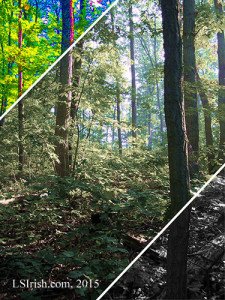 Combining the Cones and Rods Images
Combining the Cones and Rods Images
The brain combines the information sent by the cones and rods to create one image that has color hues and tonal values.
In the photo sample, left, the color image has been superimposed over the sepia tonal value image, exactly as the brain compiles the information it receives. The resulting photo is an excellent copy of the original camera photograph.



